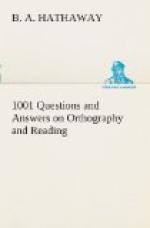16. What causes these changes?
Mostly national invasion.
17. What is assimilation of Consonants?
When an aspirate and subvocal comes together,
it is necessary
to
change the sound of one or the other, to make the
combination
pronounceable.
18. What is meant by an Element of
Speech?
An indivisible portion of language.
19. What is a Sonant sound?
One uttered with intonated or resonant
breath.
20. In changing the word traffic to
trafficked, why supply the
letter
k?
To preserve the proper sound of c.
21. Under what condition is a consonant
never doubled at the end
of
a word?
When immediately following a diphthong.—Webster.
22. When is C followed by K in spelling?
Words ending with the sound of k, and
in which c follows the vowel.
23. Give some examples.
Back, black, fleck, etc.
24. Are there any exceptions?
There are, as sac, arc, etc.
25. Why is the word Humbugged spelt
with two g’s?
To prevent sounding the g like j.
26. Give some words spelled differently
in the U.S. and in
England.
Woolen—woollen, honor—honour,
etc.
27. When do words, ending in double
e, drop one e on taking an
additional
syllable?
When the suffix begins with e.
28. Why?
To prevent three e’s coming together.
29. Does pluralizing a word ever change
the accent?
Sometimes it does.
30. Give an example.
An’tipode—Antip’odes.
31. In such words as Defense, which
is correct, se or ce for the
termination?
Se, because the s belongs to the
words from which they are
derived.—Webster.
32. Should words of English origin
end in ise or ize?
Ize; same as those from the Greek.
33. Are there any exceptions to these
rules?
There are; as advertise, from English,
etc.
34. Are the words ox, calf, sheep,
and pig of French or Saxon
origin?
Saxon.
35. From what language do the words
beef, veal, mutton, and pork
come?
The Norman-French.
36. What is a Lexicon?
A Dictionary.
37. What is an irregular sound?
Sound of a Redundant letter.
38. How are words divided as regards
Specie?
Primitive and Derivative.
39. How may the meaning of a word be
changed?
By accent; as Aug’ust, August’.
40. What is an irregular derivative?
One in which the letters of the root are
changed in forming the
derivative.




